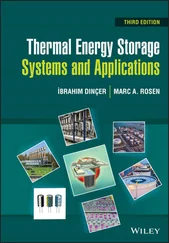NITIN KUMAR - Thermal Food Engineering Operations
Здесь есть возможность читать онлайн «NITIN KUMAR - Thermal Food Engineering Operations» — ознакомительный отрывок электронной книги совершенно бесплатно, а после прочтения отрывка купить полную версию. В некоторых случаях можно слушать аудио, скачать через торрент в формате fb2 и присутствует краткое содержание. Жанр: unrecognised, на английском языке. Описание произведения, (предисловие) а так же отзывы посетителей доступны на портале библиотеки ЛибКат.
- Название:Thermal Food Engineering Operations
- Автор:
- Жанр:
- Год:неизвестен
- ISBN:нет данных
- Рейтинг книги:5 / 5. Голосов: 1
-
Избранное:Добавить в избранное
- Отзывы:
-
Ваша оценка:
- 100
- 1
- 2
- 3
- 4
- 5
Thermal Food Engineering Operations: краткое содержание, описание и аннотация
Предлагаем к чтению аннотацию, описание, краткое содержание или предисловие (зависит от того, что написал сам автор книги «Thermal Food Engineering Operations»). Если вы не нашли необходимую информацию о книге — напишите в комментариях, мы постараемся отыскать её.
Presenting cutting-edge information on new and emerging food engineering processes,
, the first volume in the new series, “Bioprocessing in Food Science,” is an essential reference on the modeling, quality, safety, and technologies associated with food processing operations today.
This outstanding new volume:
Audience:
Thermal Food Engineering Operations — читать онлайн ознакомительный отрывок
Ниже представлен текст книги, разбитый по страницам. Система сохранения места последней прочитанной страницы, позволяет с удобством читать онлайн бесплатно книгу «Thermal Food Engineering Operations», без необходимости каждый раз заново искать на чём Вы остановились. Поставьте закладку, и сможете в любой момент перейти на страницу, на которой закончили чтение.
Интервал:
Закладка:
2.6.2.2 Application for Inactivation in Food Sector
Log reduction of E. coli, Shigella, and Salmonella present in black pepper were studied by [64] which programmed for 2 min at 50 °C with a power level of 800W. These three-microorganism got reduced to a log cycle of 6 which would hold up to 3 mins with a sample thickness of 3cm. Microwave treatment was performed on infant formula powder targeting Cronobacter sakazakii studied by [65]. At 800 and 900W the log reduction 5 log cycle. [66] currently studied the inactivation rate of Aspergillus niger present in garlic which resulted in reduction varying between 1.12 and 1.16 at a microwable temperature of 50 °C. This experiment was conducted using a microwave drum dryer using Weibull, Page, and Bigelow models. Therefore, this model proved to be perfectly fitted to predict the reduction rate of inactivation of Aspergillus niger . From all the above case studies it was inferred that treating the food products with microwave proves to be promising for a wide range of products on an industrial scale as it maintains the quality and preserves the nutritional aspects of the products. Though there are studies with different vegetables, more research has to be conducted to verify the exact nature retained at the end of the experiment for various other food powder products and which could be done on a wider scale level.
2.6.3 Radiofrequency Heating
2.6.3.1 Principle and Mechanism
In the electromagnetic spectrum, radiofrequency waves fall in a frequency range of 30–300 MHz. This method works depends upon the dielectric properties of the edible sample, where with help of an indirect mode of heating they treat the target product initially with electrical energy which is then converted to radiation mildly releasing the heat [67]. Radiation from radiofrequency are non-ionizing so therefore the food molecules are not disoriented, which is the main bonus point in the process of microbial inactivation. The advantages of this process are the time consumption which is reduced remarkably, making it a feasible application in food industries for different unit operation.
Some of the chief factors on which efficacy is highly dependent for the treatment of microbial decontaminations are moisture content of the sample, temperature a frequency, targeted microorganism, and sample depth. The current study suggested that the frequency of the microwave makes the condition favorable for microbial decontamination even if it exists in food with lower moisture content. This method favors all types of food material as it works as electrothermal pasteurization which is chemical-free [68].
The principle involved in inactivating microbes by heating through radiofrequency is that the cells of the microbes get thermally injured even at a reduced heating rate as the heat develops within the cells of the microbes causing eventual destruction of the microbes [69]. RF energy combining with other different thermal methods shows synergistic effects, notably making the RF pasteurization efficient particularly for agricultural materials having less moisture content [70]. Due to the radiation mode of heating DNA of the microbial cells absorbs directly fluctuating the structure of the cell and its functionality. Radiofrequency is used for uniform heating of food products even for power products as the treatment usually depends upon the cell structure of the focused organisms.
2.6.3.2 Application for Inactivation in Food Sector
Authentication of microbial content using radiofrequency heating was done for wheat by [71]. The log reduction microorganisms Enterococcus faecium and Salmonella enteritidis were investigated. It was calculated that it took 18 min for Salmonella enteritidis and 25mins for Enterococcus faecium to reach 5 log reduction at 85°C. Similarly, [72] studied the effect of radiofrequency heating the same pepper to decontaminate Salmonella typhimurium by adjusting the aw to 0.57-0.71. The outcome was a reduction of the log cycle between 2-3. Another study was carried by [73] utilizing radiofrequency for the 80s at 90 °C for dried black pepper and the outcome was a remarkable reduction 7 log cycle of S. Typhimurium and E. coli . When this log reduction is compared with infrared and microwave, it was the best and highest, but got a little demerit as the moisture content was reduced drastically. Similarly, [74] used broccoli for their experimental research to treat it at 6 kW which showed a reduction by 4.2 and maintaining the quality attributes and preserve the color from degradation. Therefore, mesophilic bacteria work best in radiofrequency heating by attaining the desired log reduction and also maintaining and preserving the quality, sensory and nutritional aspects of the food product for decontamination of the microbes.
2.6.4 Instant Controlled Pressure Drop Technology (DIC)
2.6.4.1 Principle and Mechanism
This technique is the thermochemical process which is built on the notion of auto-vaporization and thermodynamics of instantaneity. This concept is introduced by exposing the sample to a short period of saturated steam and then an immediate drop of pressure is applied until it gets into the vacuum. Prominent mechanical stress is applied after the pressure drop which subsequently results in cooling the water promptly and then auto vaporizing it [75]. The DIC technology testifies as a strong and promising system for inactivation and decontamination in food products and works best with the food products with increased surface area contributing to the reduction of log cycle to an estimated level. The efficiency of this technology depends upon the critical factors like expansion property of food, level of vacuum developed, size of the particles, mechanical and thermal stress, microbes variety volatile content, and pressure drop.
This technique alters the cellular structure and component of the microorganisms and this change is also irreversible therefore and dominating process in the food sector for decontamination. The major factor of this mechanism has two main features which are relaxation of pressure and controlled thermomechanical process of the targeted cell of the microbes. The process of the techniques is as follows: exposing the sample to the vacuum stage, homogenizing it, flowed by an instant drop of pressure, and initiation mechanical stress by releasing the atmospheric pressure causing the cell to explode [76]. Not only mechanical stress but also thermal stress is applied which is effective for the inactivation of the microbes. The procedure of auto-vaporization has likewise been stated to generate a mechanical constraint that performs on the focused cell of the microbes especially the walls of the spores. This technique is known for conserving the nutritional content of the specific food products as well as preserving the organoleptic qualities.
2.6.4.2 Application for Inactivation in Food Sector
Mycotoxin decontamination from apple pomace was studied by [77], where the treatment was performed to inactivate Aspergillus niger using DIC at 0.2–0.6 MPa. The outcome of the treatment showed remarkable results by increasing the flavonoids to an extreme of 800% after the process was complete and as well as improving the drying kinetics, log reduction, and quality characteristics of the product significantly. Similarly, Salmonella and Staphylococcus aureus inactivation was evaluated by [76] in which they checked the response of instant pressure drop in skim milk and seaweed. The total time taken for treatment was 40 s and taking into the counting of the targeted organism was done through the LASAT method, and with this, the DIC method proved to be best, giving desirable outcomes in inactivating the above-mentioned microorganisms which were 100% for seaweed and more than 87% for skim milk. Another special combination case experimented with a heated air temperature of 50 °C plus the DIC by [77]. This combination was performed to confirm that the count of bacterial injury was high in the case of DIC application as compared to when no DIC treatment was done. Additionally, the scientists confirm that this process helped in preserving all the nutritional components like vitamins and minerals and hence giving the best possible results in terms of quality. Subsequently gathering and investigation the above-mentioned work we can infer that DIC plays a vital role and effectively contributes to the decontamination process of microorganism because of its mild heating system and in addition, without hampering the qualitative part of the food product.
Читать дальшеИнтервал:
Закладка:
Похожие книги на «Thermal Food Engineering Operations»
Представляем Вашему вниманию похожие книги на «Thermal Food Engineering Operations» списком для выбора. Мы отобрали схожую по названию и смыслу литературу в надежде предоставить читателям больше вариантов отыскать новые, интересные, ещё непрочитанные произведения.
Обсуждение, отзывы о книге «Thermal Food Engineering Operations» и просто собственные мнения читателей. Оставьте ваши комментарии, напишите, что Вы думаете о произведении, его смысле или главных героях. Укажите что конкретно понравилось, а что нет, и почему Вы так считаете.












